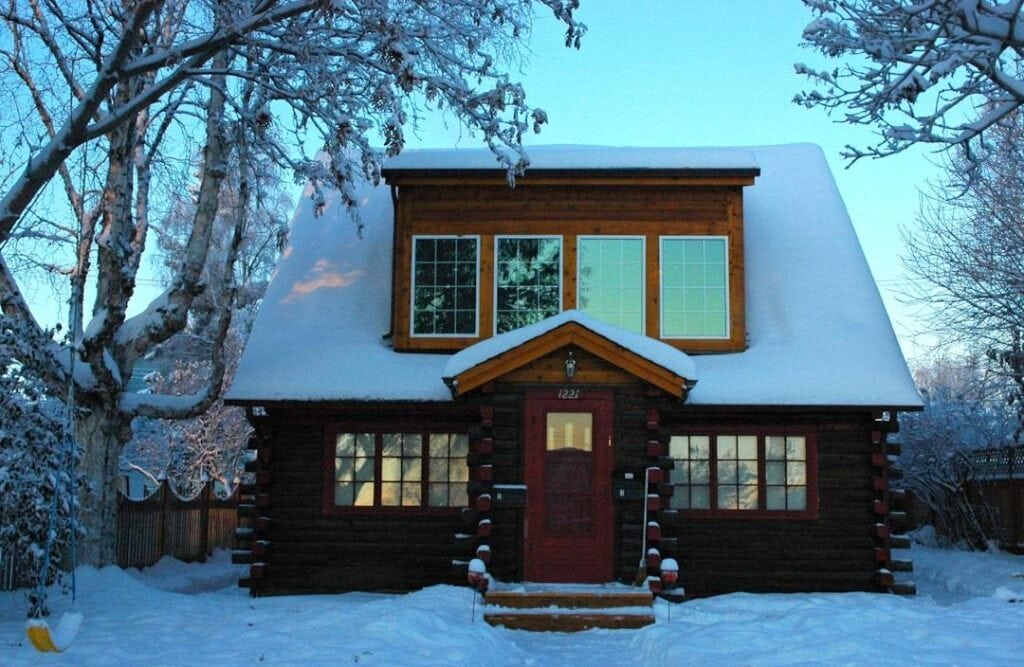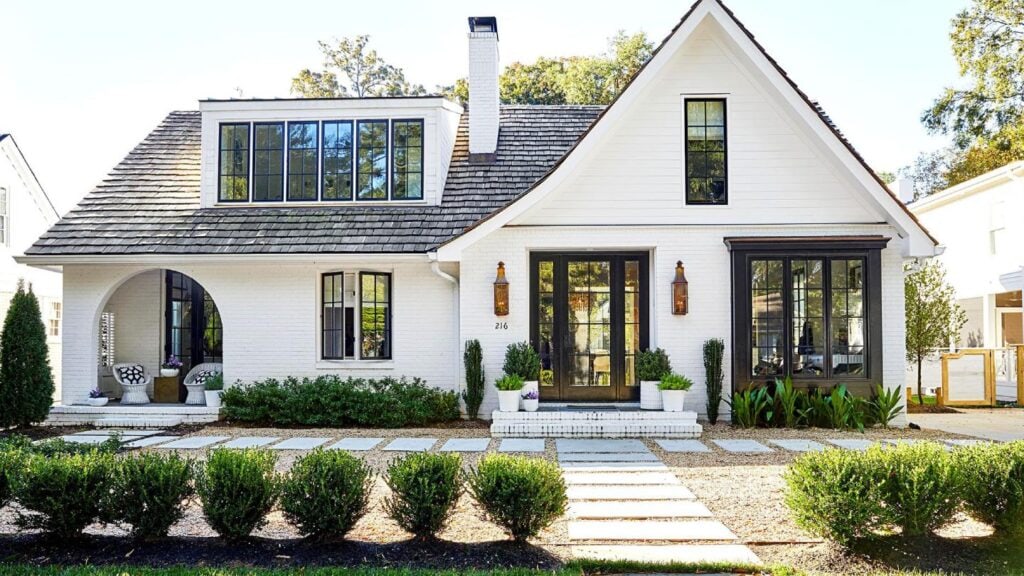Painting your home’s exterior in the winter sounds like a tricky affair, but it’s entirely doable with the right know-how. This guide breaks down everything you need to consider, from preparing surfaces for cold-weather painting to choosing the best materials that withstand low temperatures. Embarking on a painting venture during the frosty months might seem daunting, yet we’re set to unveil expert advice that not only promises triumph but also highlights the unexpected advantages this cool period brings to your endeavor.
You’ll discover the hazards involved and master strategies to dodge them, guaranteeing your painting endures well after winter’s thaw. Additionally, through real-world anecdotes, you’ll grasp the heights achievable with the right insight and groundwork.
By the end of this read, you’ll be equipped to make an informed decision on whether tackling this task yourself or calling in professionals is your best bet during the winter months.
Table of Contents:
- Understanding the Basics of Winter Painting
- Preparing Your Home’s Exterior for Winter Painting
- The Right Tools and Materials for Winter Exterior Painting
- Professional Tips for Successful Winter Painting
- Potential Risks and How to Mitigate Them
- Benefits of Painting Your Home in the Winter
- Real-Life Examples of Successful Winter Exterior Painting Projects
- Choosing Between DIY and Hiring Professionals for Winter Painting
- FAQs in Relation to Can Home Exteriors Be Painted During the Winter
Understanding the Basics of Winter Painting
Believe it or not, with today’s advancements in paint technology and proper techniques, it’s doable—and can even have its perks.
Why Consider Winter?
The idea of painting outdoors when it’s cold enough to freeze your tail off might seem crazy at first. However, lower humidity during winter months helps paint dry quicker and more evenly. Plus, professional painters often have more availability in their schedules during these cooler months.
This doesn’t mean you should grab a brush on the coldest day of the year. Paint manufacturers now offer products specifically formulated for lower temperatures. These paints can be applied effectively when temperatures are as low as 35°F (about 2°C).
Selecting Your Paint Wisely
Not all paints are up for the challenge of a chilly makeover. Look for labels that mention terms like “low temperature” or “cold weather” formulas. These concoctions are designed to handle whatever Jack Frost throws at them without cracking or peeling once spring hits.
You’ll also want to make sure your chosen hue looks just as stunning under gray skies as it does under the summer sun—some colors change appearance based on lighting conditions.
Battling Condensation and Dew
Morning dew and frost can ruin fresh paint faster than spilt coffee on white pants. To avoid this mess, professionals start their work after sunrise has zapped away any moisture and wrap up before dusk invites it back again.
So yes while painting outside in colder temps is unorthodox advice akin to wearing socks with sandals—it works if you know how to do it right.
Preparing Your Home’s Exterior for Winter Painting
Here’s how to roll out the red carpet for your paint job.
The Right Temperature is Key
Winter painting isn’t just about battling the cold; it’s about picking your battles wisely. Most paints need temps above 35°F to cure properly. Use a thermometer to check not just air temperature but also surface temp, as they can differ.
If you’re thinking of pushing boundaries and painting below recommended temperatures, think again. Specialized low-temp exterior paints exist that work down to 35°F. These aren’t just regular paints with antifreeze; they’re engineered for cold weather adhesion and flexibility.
Clean Surfaces Make Happy Paints
Snow and ice are beautiful on trees but troublesome on surfaces meant for painting. A clean canvas is crucial so start by removing any dirt or mildew—pressure washing works wonders here—but make sure everything dries completely before you start applying paint.
Mold or mildew sticking around? Treat affected areas with a mixture of bleach and water (1 part bleach to 3 parts water) before rinsing off thoroughly and drying. This step ensures nothing undercuts your paint job from beneath.
Tackling Moisture – The Unseen Saboteur
In winter, moisture becomes an invisible ninja attacking your paint job from all angles due to increased humidity levels outside and inside your home. Seal windows and doors well ahead of time because drafts bring moisture—and potential peeling problems—with them.
The Right Tools and Materials for Winter Exterior Painting
When it comes to painting your home’s exterior in the winter, not just any paint or brush will do. You need tools and materials that laugh in the face of cold weather.
Choosing Your Paint Wisely
Gone are the days when you had to wait for spring thaw to freshen up your home’s exterior. Thanks to modern technology, certain paints now cater specifically to colder climates. Nowadays, these concoctions are engineered with a reduced temperature tolerance, making it feasible for them to solidify correctly despite the chill. A popular choice among professionals is acrylic-latex paint designed for low temperatures, which can be applied as long as it’s above 35°F.
But remember, while picking out your paint color might be fun, ensuring its suitability for winter conditions is crucial. Look into products with labels indicating they’re suitable for cold weather application; these are engineered not only to withstand chillier temps but also often offer faster drying times—a real asset when daylight is scarce.
Necessary Tools For the Job
No painter—amateur or pro—should go into battle against the elements without their armor. In this case: quality brushes and rollers are designed for outdoor use under varying conditions.
Synthetic bristle brushes work best with water-based paints because they don’t absorb moisture like natural bristles do. As such, they maintain their shape better in damp or humid conditions you might encounter outside during winter months.
Rollers should have a thicker nap if you’re working on rough surfaces like stucco since they can hold more paint and deal with texture effectively without getting bogged down by cool air, one seasoned professional suggests from firsthand experience dealing with various exteriors across seasons.
Tackling Prep Work Like A Pro
Cleaning and prepping your surface correctly cannot be overstated—it’s critical no matter what season you decide to undertake an exterior painting project.
Additionally, another expert adds, that using a high-quality primer can make all the difference, especially in sealing out moisture that could compromise your topcoat’s durability through the wetter parts of winter.
Professional Tips for Successful Winter Painting
Believe it or not, painting your home’s exterior in the winter can be like trying to ice skate uphill – possible but packed with potential pitfalls. But with a few pro tips up your sleeve, you’ll glide through the project smoother than a Zamboni on an ice rink.
The Right Temperature is Your Best Friend
Picking the perfect day isn’t just about avoiding rain or snow; temperature plays a starring role. Most exterior paints need temps above 35°F to properly adhere and dry. So, keep an eye on that thermometer and aim for mild winter days.
If you’re questioning what paint works best when Jack Frost is nipping at your nose, look no further than low-temperature formulas designed specifically for cooler weather applications. These special blends give you more flexibility by working well even as temperatures dip.
Timing Is Everything
You know those short winter days? They’re shorter than my patience when I’m waiting in line for coffee. This means less daylight to work with, so start early but not too early. Letting the sun warm up surfaces ensures better adhesion and drying of the paint.
Sunlight’s angle during winter months affects how quickly areas dry, potentially causing uneven drying times across different parts of your house. To prevent this issue before it starts making trouble, plan which sides of your house to tackle based on where and when they receive sunlight throughout the day.
Battling Humidity & Dew Point
A hidden nemesis of wintertime painting is humidity paired with dew point levels – think Batman versus The Joker level rivalry here. High humidity can mean longer drying times while lower temps increase moisture content in air which impacts how well paint adheres. Use hygrometers to measure outdoor humidity levels and try painting during drier periods whenever possible.
Thus, equipped with this knowledge, embarking on an outdoor painting venture in the cooler seasons need not immobilize you with apprehension. Instead, following professional advice helps ensure successful outcomes despite chillier challenges.
Potential Risks and How to Mitigate Them
Understanding the Impact of Low Temperatures on Paint
The cold doesn’t just make you shiver; it makes your paint act funny, too. Most paints require temperatures above 35°F to cure properly. Below this magic number, the paint may not adhere well, leading to peeling or blistering later on.
To avoid a painting disaster, use specially formulated low-temperature exterior paints. These items are crafted to endure chillier climates, ensuring their performance doesn’t falter. Always check the manufacturer’s recommendations for temperature guidelines before starting your project.
The Challenge of Drying Times
In winter, shorter days mean less daylight for drying paint, and humidity can play tricks on drying times as well. What looks dry might be deceivingly damp beneath the surface.
To tackle this challenge head-on, plan your painting schedule around the weather forecast and start early in the day to maximize sunlight exposure. Consider using additives that accelerate drying time but consult with professionals or product guidelines first to ensure compatibility with your chosen paint.
Battling Unexpected Weather Changes
Sudden rain or snowfall? Welcome to winter’s unpredictability. Water is kryptonite for fresh paint—it can wash away all your hard work in minutes.
The best defense against unexpected weather is preparation and flexibility in scheduling: keep an eye on reliable weather forecasts such as The Weather Channel, and ready tarps and covers at a moment’s notice if needed. Also, consider erecting temporary shelters if you’re tackling larger areas or projects expected to run over several days. This proactive approach lets you shield freshly painted surfaces from unwanted moisture until they’ve had enough time under their belt—or rather under their coat—to stand up against nature’s elements.
Benefits of Painting Your Home in the Winter
Painting your home in winter might sound as counterintuitive as wearing flip-flops during a snowstorm, but it has some surprising benefits. Delving into the colder months might reveal it’s the perfect opportunity to give your house’s outside a fresh coat.
Reduced Humidity and Dry Air Speed Up Drying Times
The crisp winter air isn’t just good for making snowmen; it can also help paint dry faster. Unlike summer, when humidity is like an uninvited guest at a barbecue, winter brings lower moisture levels. This means that each coat of paint dries quicker, letting you finish the project in less time. Just make sure temperatures stay above the paint’s recommended guidelines.
This speedy drying isn’t only about saving time; it also reduces the chance of dust and debris sticking to wet paint—a common headache during warmer months.
Better Pricing and Availability from Professional Painters
If DIY isn’t your style, here’s another win: professional painters often have more availability in winter. Since demand is lower, you’re not only more likely to get on their schedule but you might also snag a better rate too.
In fact, studies show that off-season projects can come with significant cost savings because contractors are filling gaps between bigger jobs or trying to keep their teams busy year-round.
Faster Completion Times for Your Project
Last but certainly not least, painting your house in winter often means wrapping up sooner than expected—weather permitting. With fewer rain delays and shorter drying times thanks to that cool dry air we talked about earlier, your project moves along at a brisk pace. That gives you back weekends sooner rather than later so that come spring, you’re free to tackle other home improvement adventures—or simply enjoy relaxing outside beside freshly painted walls.
Real-Life Examples of Successful Winter Exterior Painting Projects
Think painting your house in winter is a no-go? Think again. Folks everywhere are defying the old norms, pulling off their chilly season endeavors with flying colors. Here are some tales from the frosty front lines.
The Challenge of Cold Weather
In Colorado, John and Sarah decided to take on their peeling siding in December, despite temperatures often dipping below freezing. They chose a paint specially formulated for low temperatures and made sure it was sunny on painting days. The result? A flawless finish that cured perfectly, thanks to their meticulous planning.
Amy in Minnesota faced similar hurdles but added another layer to her strategy—timing her project around the warmest part of the day. By focusing her efforts during those precious few hours when temps were highest, she maximized drying time before the mercury plummeted each night.
Tips That Made The Difference
So what can we learn from these intrepid homeowners?
- Pick the right paint: Products designed for cooler weather can make or break your project.
- Sunshine is your friend: Even if it’s cold out, sunlight helps paint cure better than overcast skies do.
- Timing is everything: Paint during the warmest part of the day and give plenty of time for drying before it gets too chilly at night.
The key takeaway here isn’t just about braving colder conditions; it’s about smart preparation meeting opportunities. With a bit more thought into materials and timing, even winter can be an ideal time for giving your home’s exterior a fresh coat.
Choosing Between DIY and Hiring Professionals for Winter Painting
The Pros of DIY Winter Exterior Painting
Going the DIY route in painting your home’s exterior during winter can feel like gearing up for a chilly adventure. Embellishing your dwelling by hand delivers a unique satisfaction, derived from the act of enhancing its aesthetics personally. You have complete control over the timeline, allowing you to work at your pace, which can be especially appealing when daylight hours are shorter.
Budget-wise, doing it yourself usually means lower costs since you’re saving on labor expenses. This is an attractive option if you’re comfortable navigating cold-weather paint application challenges and have done thorough research or possess previous experience.
The Advantages of Professional Winter Exterior Painting
Hiring professionals brings its set of perks, starting with their expertise in handling the unique demands of winter painting. They know exactly how to prep surfaces to combat moisture issues common in colder months and select the right products that will withstand low temperatures.
Expert painters not only streamline the task with their arsenal of gear and methods, ensure swiftness without sacrificing craftsmanship. This means less time spent braving the cold for you. Plus, many contractors offer warranties on their work—giving you peace of mind about durability through the seasons.
Making Your Choice: Balancing Cost Against Convenience
In deciding between DIY or professional help for your winter exterior painting project, consider factors like budget constraints versus potential headaches from unforeseen challenges due to weather conditions—a reality when working outside this season—and how much value you place on guarantees against peeling or chipping down the line.
If the budget is tight but confidence high, diving into a self-led project could be rewarding both financially and personally.
But if ensuring a quick turnaround before harsher weather sets in matters more,
leaning on professional expertise might just save not only time but also future repair costs.
FAQs in Relation to Can Home Exteriors Be Painted During the Winter
What temperature is too cold for exterior paint?
Below 35°F is too chilly. The paint struggles to stick and won’t dry right.
How do you paint a house in the winter?
Pick a warm day, use winter-grade paint, and keep an eye on weather forecasts.
What is the minimum temperature to paint outside with Sherwin Williams?
Sherwin Williams suggests at least 35°F for their paints but check specific product guidelines.
Can you paint exterior brick in the winter?
You can, but ensure it’s above-freezing temperatures and that your brick isn’t damp or icy.
Yes, home exteriors can be painted during the winter. This guide laid out how to do it right, from prepping your house to picking the best paints for cold weather.
We delved into expert advice and actual success stories, uncovering the secrets to victory. Remember: proper prep is key, and choosing the right paint matters a lot.
Risks? Sure, they exist. But now you know how to dodge them.
The perks of winter painting—like lower humidity—are too good to ignore. Decide if you’re going DIY or bringing in pros based on what we covered.
In short: armed with this knowledge, tackling that paint job in colder months just got a whole lot easier. You’ve got this!

Josh Strange embarked on a new journey in 2017, relocating to the vibrant city of Fort Worth, TX, fueled by ambition and a vision for growth. His professional journey began in the aircraft industry, where he spent over seven years working on the esteemed F-15 & F-35 programs. Despite the thrill of the aviation sector, Josh yearned for more personal fulfillment.
Driven to contribute something lasting and meaningful, Josh took a daring leap of faith in the autumn of 2020. He left his secure career to establish his enterprise. Drawing inspiration from his father, a seasoned painter, Josh noticed an unmet need in the painting industry. Painting ran in the Strange family bloodline.
With a clear vision, Josh set out to create the premier painting service in the DFW area. His company was built on professionalism, customer satisfaction, and a relentless drive to deliver the best painting contractor experience. Josh’s commitment to excellence has positioned his business as the go-to choice for all painting needs in the region.



